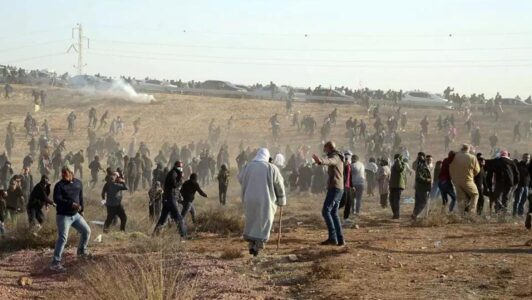
Hamas rebrands again as ‘defender of the Negev’
A year after Hamas-inspired violence swept through Israel’s mixed cities during Operation Guardian of the Walls, Hamas is forming new ties with radical elements in the Bedouin and other Arab Israelis living in the Negev.
In January, Sheikh Ikrama Sabri, Hamas’ man in east Jerusalem, paid an unusual visit to a few Bedouin communities in the Negev. Sabri expressed support for the Bedouin fight against tree planting in the Negev and tried to recruit the people he met with into the struggle against Israel he has been waging for years. He also invited them to visit Al-Aqsa Mosque.
Sabri told the people he visited about the processes that had turned Jerusalem in general and the Sheikh Jarrah neighborhood in particular into a flashpoint of the “occupation.”
At almost the same time, Hamas issued a statement condemning “attempts to Judaize the occupied Negev.” Hamas called on Arab Israelis to “take action against the Israeli occupier’s policy of Judaization” and “anchor the Arab-Palestinian identity of the occupied land.”
This was the first signal that Hamas was changing its tack – in addition to branding itself “defender of Jerusalem,” it was also adopting the identity of “defender of the Negev.” The organization, security officials say, began inciting the Bedouin, working in conjunction with Islamist elements in Israel, like Sabri, members of the outlawed Northern Branch of the Islamic Movement, and hostile officials in Bedouin tribes.
In the past few weeks, as Land Day approached, Hamas’ targeted incitement of Bedouin shifted gears. Two weeks ago, Hamas announced it was setting up a “national authority to defend the Palestinian people in the occupied 1948 borders.” Spokesmen for the new organization focused on the Negev. Its leader, Mohsen Abu Ramadan, made it clear that “The [Gaza] Strip would enlist to support the Negev residents’ struggle in a series of actions that will start on Land Day. All activity is being coordinated between the Palestinian organizations in Gaza and Arab Israeli leaders.”
It wasn’t long before Hamas’ “partner” was revealed Atia al-Azzam, a resident of the Bedouin village Abu Talul and head of the local authority that oversees unrecognized Bedouin villages in the Negev. A few days ago, al-Azzam explained that the Negev residents felt that “our Palestinian brothers stand beside us morally, and will strengthen our determination to continue our battle for our homeland…”
The coordination is taking place at the highest level. Chairman of the Negev Bedouin Higher Steering Committee, former MK Juma Azbarga, was the first to welcome the establishment of the new Gaza committee. Azbarga said that Israel had launched an all-out assault on the Negev by approving two new cities to be built there and intended to “break” the Negev Arabs’ resistance to “expulsion plans.
Later came chairman of the Arab Higher Monitoring Committee and former MK Mohammad Barakeh remarks. Barakeh praised the establishment of the committee to “protect Palestinians within the 1948 borders” and said that it had come at the “right time.” Barakeh also spoke about the Negev.
This came after Barakeh’s remarks a few months ago, which stayed off the media radar, that “In the last Intifada [referring to the events of May 2021], there were loci of resistance to the Zionist oppression in Jaffa, Haifa, Acre, Lod, and Ramle, which they tried to write off, pervert, and remove from the map of Palestine. They rose up and said, ‘Palestine is here.’ It was called Palestine, and it is again called Palestine.”
The trend, therefore, is clear and hard to mistake. The recent incident sin the Negev, especially the latest terrorist attacks, are part of an ethno-religious uprising by Palestinians and Arabs on both sides of the Green Line. The declared common ground for the “internal Palestinians” (Arab Israelis) and the Arabs in Judea and Samaria and Gaza is trifold: the Nakba (the ‘disaster’ of the founding of the state of Israel), the “right of return”, and a unified Palestinian identity.
What appeared to be deep-seated currents are now rising to the surface. Some Arab Israelis are distancing themselves from Israel. Many of them identify with the Palestinian enemy and their false narratives, and their commitment to a weakened Jewish state. The Hamas-Negev axis, which is another branch of the Hamas-Jerusalem axis, is a symptom.
Source: Israel Hayom





